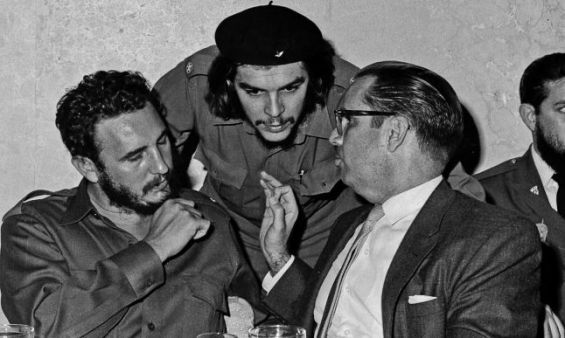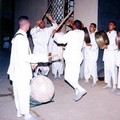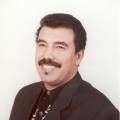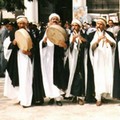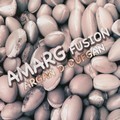Morocco was not only a refuge for celebrities, stars and artists but also a destination for military revolutionists and political leaders who shaped the international political scene in the end of 50s and beginning of 60s. And as the world was torn to two blocs, a Western and Eastern one, the Kingdom of Morocco played a ground-breaking role in inspiring and providing assistance for militants from one of these powers.
In this episode Yabiladi is putting three political figures under the spotlight. And for those who are not aware of this chapter, the Argentine guerilla leader Che Guevara, the Cuban communist revolutionary politician Fidel Castro and the anti-apartheid South African president have been to the North African Kingdom.
Che Guevara invited by Abdallah Ibrahim
Starting with the oldest visits of the three, Ernesto «Che» Guevara’s trip to the kingdom was mainly inspired by Abd-el-Krim al-Khattabi's guerilla tactics. Influenced by the Riffian leader, the two met in Egypt.
In January 1959, and while attending a reception hosted by the Moroccan embassy in Cairo and attended by Abdelkarim El Khattabi, who has been living in Egypt after seeking asylum in 1947, Che Guevara met with his Guerilla mentor.
It happened that the same reception where the two revolutionists sat and spoke in Spanish for hours, was also attended by the newly appointed Moroccan Prime Minister, Abdallah Ibrahim. The latter, and during his meeting with Che, who was at the time Minister of Finance and President of the Cuban National Bank, assked him to pay Morocco a visit.
This was confirmed by Abdellatif Housni, a confidant of the former Prime Minister as indicated by Zamane. Replying to Ibrahim’s invitation, Che Guevara landed in Morocco eight months later. In the account provided by Zamane and based on the book of Mohamed Louma entitled «Des années de résistance au milieu de la tempête», Abdallah Ibrahim was the last one to know about this visit.
According to the same source, the military theorist arrived in Rabat and was immediately put in a guarded hotel room down town where he was kept for 48 hours before Ibrahim intervened. Abdellatif Housni recalls that «the fact that Che Guevara got off the plane with his comrades, all dressed in military uniforms, could have disturbed the police, who had doubts about the identity of these people».
As strange as it might sound, the arrest of Che Guevara and his comrades was, according to Mohamed Louma’s version of the story, an order given by «Smit Sidi», a nick name for the Crown Prince, who will become later King Hassan II.
Once the Prime Minister intervened, things got better and the Cuban delegation found its way out of the hotel in Rabat. Abdallah Ibrahim took his guests to a villa in Swissi, Rabat, where they rested. The day after, negotiations and talks took place between the Prime Minister and the Cuban delegation.
Che and his comrades were later taken to Marrakech by Abdallah Ibrahim. In the Ochre city, the delegation stayed in a house there before leaving for Casablanca and then Madrid.
Castro and the breakfast
Che Guevara was not the last Cuban official and revolutionary to visit Morocco, as in 1963 Fidel Alejandro Castro Ruz, who governed the Republic of Cuba as Prime Minister from 1959 to 1976 and then as President from 1976 to 2008, stopped in Rabat.
In April, 1963, Castro was supposed to visit the Soviet Union in one of its first official trips to the socialist states. And as any flight heading to the union, the plane had to stop in Rabat.
While staying in Rabat, Castro had the chance to meet King Hassan II. This was mentioned in the book «La Mémoire d’un Roi», where the sovereign stated that he met the Cuban leader after he requested to see him.
In fact, the two men took breakfast together and had a profound ideological discussion. «He was a man that was sticking to his guns», said the king describing Castro. «I think he went too far with his commitments, and he thought that failing to meet his promises is sometimes more damaging than simply sticking to a particular option», he said.
The two leaders’ meeting did not change their beliefs and political stands. A few months later the sand war broke out between Morocco and Algeria and Castro decided to side with the neighboring country opposing King Hassan II.
Mandela in Oujda
Away from Marxism, the South African leader, Nelson Mandela was also one of the politicians who came to Morocco during the same period.
His trip to North Africa was mentioned by the book «Nelson Mandela : Ending Apartheid in South Africa» by Samuel Willard Crompton, who wrote : «In 1961, Mandela went on a tour of several African and European nations».
«He snuck out of South Africa and visited Algeria and Morocco. There he learned how to fire a gun, and he practiced his marksmanship».
In fact, Mandela collaborated with Abdelkrim El Khatib, Minister of State for African Affairs at the time and the founding father of Justice and Development Party (PJD).
From 1960 to 1962, he was staying in Morocco. In Oujda, he met with the leaders of the National Liberation Front (FLN), a socialist political party in Algeria. At the time the Kingdom was a refuge for the figures of resistance in Africa. They were all coming to Morocco inspired by King Mohammed V and the leaders of the Nationalist Movement such as Allal El Fassi, Mehdi Ben Barka and Mohamed El Basri.
It is during this period that the young Mandela joined Houari Boumediene, Ben Bella, Mohamed Boudiaf and Agustino Neto (the first president of the Republic of Angola between 1975 and 1979), Amilcar Cabral, founder of the African Party for the Independence of Guinea and Cape Verde, and many others who had taken refuge in Morocco.





 chargement...
chargement...




